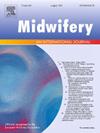Trajectories of prenatal depression and their prediction of adverse pregnancy outcomes based on nomograms in Mainland China—Results from a national longitudinal survey
IF 2.5
3区 医学
Q1 NURSING
引用次数: 0
Abstract
Background
Cross-sectional data are commonly used to explore the relationships between prenatal depression and its relevant outcomes. Longitudinal studies of the influence of prenatal depressive trajectories on pregnancy outcomes are scarce. This study used nomograms to evaluate prenatal depressive trajectories as predictors of adverse pregnancy outcomes.
Methods
1169 participants were included in a national multicenter cohort study from five hospitals in Mainland China. Depression was measured by the Edinburgh Postnatal Depression Scale (EPDS) at 10–13, 15–18, 23–25, 30–32, and 36–37 weeks of gestation. A nomogram was constructed for each outcome based on multivariate logistic regression to evaluate the contribution of prenatal depressive trajectories to each outcome.
Results
Three different depressive trajectories were identified, namely “Low-stable,” “High-increasing,” and “High-decreasing,” accounting for 94.0 %, 4.3 %, and 1.7 % of participants, respectively. Prenatal high-increasing and high-decreasing trajectories elevated the likelihood of preterm term and small for gestational age (SGA) births occurring. Nomograms showed that prenatal depressive symptom trajectories predicted the above adverse outcomes more strongly than any other variable.
Limitations
Of the participants, 86.0 % had a education level of bachelor or higher. As the EPDS is highly aligned with the clinical diagnosis, it was used to assess depression levels.
Conclusions
Our study suggests that prenatal depressive trajectories can predict the likelihood of preterm and SGA births. These findings underscore the importance of early screening, identification, and intervention for prenatal depression.
中国大陆孕妇产前抑郁的发展轨迹及其对不良妊娠结局的预测——基于一项全国性的纵向调查
背景横断面数据通常用于探讨产前抑郁及其相关结果之间的关系。关于产前抑郁轨迹对妊娠结局影响的纵向研究很少。本研究使用线图来评估产前抑郁轨迹作为不良妊娠结局的预测因子。方法1169名受试者纳入中国大陆5家医院的全国性多中心队列研究。在妊娠10-13周、15-18周、23-25周、30-32周和36-37周采用爱丁堡产后抑郁量表(EPDS)测量抑郁程度。基于多变量逻辑回归,为每个结果构建了一个nomogram,以评估产前抑郁轨迹对每个结果的贡献。结果确定了三种不同的抑郁轨迹,即“低稳定”,“高增加”和“高减少”,分别占94.0%,4.3%和1.7%的参与者。产前高增加和高减少的轨迹增加了早产和小胎龄(SGA)出生的可能性。无形图显示,产前抑郁症状轨迹比任何其他变量更能预测上述不良结局。研究对象中,86.0%的受教育程度为本科及以上。由于EPDS与临床诊断高度一致,它被用于评估抑郁水平。结论产前抑郁轨迹可以预测早产和SGA出生的可能性。这些发现强调了早期筛查、识别和干预产前抑郁症的重要性。
本文章由计算机程序翻译,如有差异,请以英文原文为准。
求助全文
约1分钟内获得全文
求助全文
来源期刊

Midwifery
医学-护理
CiteScore
4.50
自引率
7.40%
发文量
221
审稿时长
13.4 weeks
期刊介绍:
Midwifery publishes the latest peer reviewed international research to inform the safety, quality, outcomes and experiences of pregnancy, birth and maternity care for childbearing women, their babies and families. The journal’s publications support midwives and maternity care providers to explore and develop their knowledge, skills and attitudes informed by best available evidence.
Midwifery provides an international, interdisciplinary forum for the publication, dissemination and discussion of advances in evidence, controversies and current research, and promotes continuing education through publication of systematic and other scholarly reviews and updates. Midwifery articles cover the cultural, clinical, psycho-social, sociological, epidemiological, education, managerial, workforce, organizational and technological areas of practice in preconception, maternal and infant care.
The journal welcomes the highest quality scholarly research that employs rigorous methodology. Midwifery is a leading international journal in midwifery and maternal health with a current impact factor of 1.861 (© Thomson Reuters Journal Citation Reports 2016) and employs a double-blind peer review process.
 求助内容:
求助内容: 应助结果提醒方式:
应助结果提醒方式:


